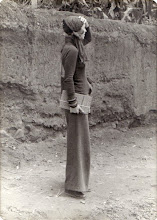Fee Fi Fo Fum - China's art market is growing by leaps and bounds, especially since the government lifted its ban on the ownership and sale of pre-communist art. Just this week, the volume of sales of "traditional" art in Hong Kong surpassed that of the US or Britain, and with average sale prices around "90K and records like $11M for a Qianlong-period throne, China has become the world's third-largest art market, according to the Economist.
I'm sure there are piles, and soon mountains, of literature on the subject of recent Chinese art history, but considering there's none in my textbooks, allow me to muse... The historiography of Chinese art must take a different, windier path than that of the linear, capitalist Western model of Church, European patrons, artist-client duo and artist-institution relationship... Other than court-ordered portraiture and the Queen's favorites, and the 1934 New Deal art funding flush in the US, state intervention in the arts has been a backseat driver. Indeed, some of the West's greatest movements have been founded in dissent and rejection of the state and status quo. Yet China has controlled not only the preservation and distribution of its ancient art, as well as the production of new art, it has controlled its markets so severely that any comparison with Western art history would end at the beginning of Robert Frost's poem: the road forks and we'd head down the road not taken. Furthermore, the tight control of publication and academics in Communist China must have influenced historiography, so that any sources since the 1920s would be seen through the lens of state pressures, rampant censorship and severe mistrust of intellectuals. That being said, now that the ban on pre-communist art has been lifted, so has the veil of mystery and not only should we re-evaluate the myriad of styles lumped together as "traditional" since 1920, but also we can begin to see contemporary creation in new lights. Although the recent spike in art market prices and circulation has concentrated heavily on the older art, it will be interesting to see where sales in contemporary lead... as I've often heard, art, like money, goes where it's taken care of. The middle and upper classes of new Chinese consumers may very well pick up the sales, but for now it looks like contemporary chinese art is the baby of Western institutions and Eastern pride - with buyers taking the art out and into the world. Will the Western and Eastern roads meet at the bank, then? Where will their histories cross, and how will we look back?
UPDATE: another article in the Economist brilliantly underlined my point by showing how Western business is booming in China's art market, establishing ties and grabbing parts of the auctioning market by bypassing government limitations. Article link, Nov 28th, 2009

Aucun commentaire:
Enregistrer un commentaire